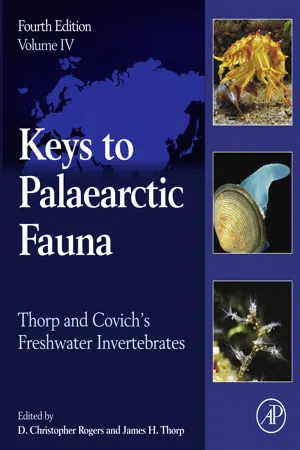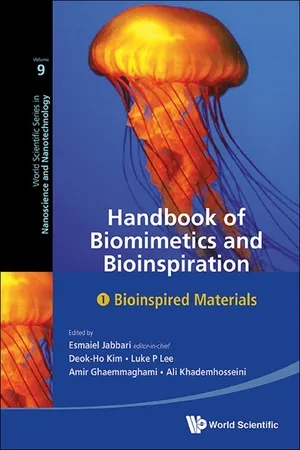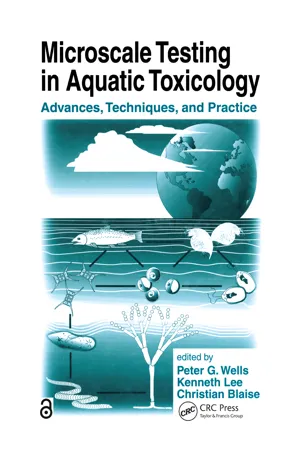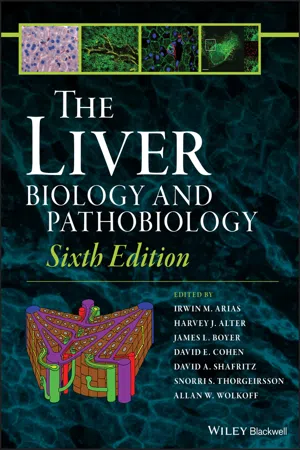Biological Sciences
Ciliates
Ciliates are a diverse group of single-celled organisms characterized by the presence of hair-like structures called cilia, which they use for movement and feeding. They are found in various aquatic environments and play important roles in nutrient cycling and food webs. Ciliates exhibit complex behaviors and have unique cellular structures, making them a fascinating subject of study in biological sciences.
Written by Perlego with AI-assistance
5 Key excerpts on "Ciliates"
- eBook - ePub
Thorp and Covich's Freshwater Invertebrates
Volume 4: Keys to Palaearctic Fauna
- D. Christopher Rogers, James H. Thorp(Authors)
- 2019(Publication Date)
- Academic Press(Publisher)
Scale 5–10 μm for (C, R, and S); 30 μm for (L, T, and W); 45 μm for (N and O); 60 μm for (N and O); 90 μm for (B, E, F, and J); and 500 μm for (V). Ciliates The Ciliates (phylum Ciliophora) form a natural group distinguishable from other protozoa by a number of specialized features, including the possession of cilia, which are short hair-like processes, at some stage in their life cycle, the presence of two types of nuclei, and a unique form of sexual reproduction called conjugation. A representative ciliate is shown in Fig. 2.1 D. The body surface is covered with cilia, which are mostly aligned in rows called kineties. The pattern of kineties is interrupted in the region of the mouth where there may be specialized oral cilia used for feeding. The cilia may be reduced in number, especially in sessile forms, or organized into larger compound ciliary organelles such as cirri. The only large group that does not always possess cilia is the Suctoria; these are sessile predators whose dispersal stages are, however, ciliated. This distinctive group is easily recognized by its feeding tentacles. The novice should take care not to confuse small, ciliated animals with Ciliates; the size range of Ciliates overlaps that of several metazoan groups such as turbellarians, rotifers, and gastrotrichs. Some Ciliates are mixotrophic due to the presence of endosymbiotic algae, or by sequestering chloroplasts from ingested algae that are kept functional in the ciliate cytoplasm (Esteban et al - eBook - ePub
Handbook Of Biomimetics And Bioinspiration: Biologically-driven Engineering Of Materials, Processes, Devices, And Systems (In 3 Volumes)
Biologically-Driven Engineering of Materials, Processes, Devices, and Systems(In 3 Volumes)
- Esmaiel Jabbari, Deok-Ho Kim, Luke P Lee, Amir Ghaemmaghami, Ali Khademhosseini(Authors)
- 2014(Publication Date)
- WSPC(Publisher)
Chapter 20BIOMIMETIC CILIA
Jae-Hyun Chung*,§ , Tae-Rin Lee†,¶ and Wing Kam Liu†,‡,∥ *Department of Mechanical Engineering, University of WashingtonBox 352600, Seattle, WA 98195, United States† Department of Mechanical Engineering, Northwestern University,2145 Sheridan Rd. Evanston, IL 60208-3111, United States‡ School of Mechanical Engineering, World Class University (WCU)Program in Sungkyunkwan University, Korea§ [email protected] ¶ [email protected] ∥ [email protected]Biological cilia are hair-like structures whose rhythmic beating provides motility for cells and micro-organisms. Cilia can offer a clue to address a current challenge of dexterous manipulation of small particles in microfluidics. Microfluidic manipulation is not efficient because of the fluid’s high viscosity, low inertia, and low molecular diffusivity, in particular, in a small volume. To overcome the challenge, a biomimetic approach that imitates the properties and behaviors of biological cilia has been intensively developed. This chapter reviews various biomimetic approaches in the contexts of design, fabrication, and actuation mechanisms. Theoretical, numerical, and experimental approaches are discussed to learn benefits and limitations of biomimetic cilia. The applications of biomimetic cilia are addressed with the corresponding challenges. Toward high throughput bioassays, micromixing and bioreactions are discussed with application of biomimetic cilia, which will have a potential impact on disease diagnosis and drug discovery.1.Introduction
Both fluid manipulation and propulsion in a fluid medium is achieved in nature using ciliary and flagellar motion. Cilia are differentiated from flagella in several aspects (Fig. 1 - eBook - ePub
Microscale Testing in Aquatic Toxicology
Advances, Techniques, and Practice
- Peter G. Wells, Kenneth Lee, Christian Blaise(Authors)
- 2018(Publication Date)
- CRC Press(Publisher)
With the proliferation of new and innovative bioassay technologies for many different organismal groups, particularly with microscale tests, Ciliates have also recently become test organisms in bioassays. There are several important reasons for this:1. Ciliates are important as recyclers and remineralizers of organic material in terrestrial and aquatic ecosystems 2. Ciliates are relatively easy to culture in the laboratory 3. Ciliates have very rapid generation (population growth) ratesCiliate bioassays have utilized a variety of test organisms; studies which have proposed these bioassays have also tested a broad range of chemical toxicants. Moreover, these studies have proposed a variety of different biological parameters as test endpoints.Some methods have been developed as part of research aimed at determining the toxicity of a specific class of chemicals (e.g., the need for a surrogate test for mycotoxin poisons of food17 ), while others have been developed as standardized methods to be used for a broad range of toxicants and toxicant mixtures.18 , 19 , 20 To date, none of these has attained the status of a standard regulatory test, although several have possibilities in this regard.A. Ciliate Species Used in Bioassays
A relatively small number of ciliate species (representing only a half dozen genera) have been used as test organisms in the bioassay methods proposed to date. This can be attributed to the fact that relatively few species of Ciliates are routinely cultured in protozoology research laboratories. Nonetheless, the species used for the majority of methods are common and ubiquitous, and their biology, ecology, and physiology are well understood. These species, therefore, are appropriate as test organisms in these bioassays. A review of the recent literature indicates that species from five genera have been used in most bioassay methods (see Table 21.1 ): Tetrahymena spp. (19 studies); Colpidium spp. (7 studies); Paramecium spp. (7 studies); Colpoda spp. (4 studies); and Euplotes spp. (3 studies). Although the use of a very limited number of genera and species is reasonable, future studies need to evaluate test methods by implementing a comparison of a method’s utility among different unrelated species to understand the variability of specific bioassay methods. Only a few studies have addressed this issue.21 , 22 , 23 - eBook - ePub
The Liver
Biology and Pathobiology
- Irwin M. Arias, Harvey J. Alter, James L. Boyer, David E. Cohen, David A. Shafritz, Snorri S. Thorgeirsson, Allan W. Wolkoff(Authors)
- 2020(Publication Date)
- Wiley-Blackwell(Publisher)
5 Primary Cilia Carolyn M. OttJanelia Research Campus, Ashburn, VA, USAINTRODUCTION
A multicellular organism has a need to coordinate multiple processes in space and time. During development, multiple cell lineages migrate and differentiate simultaneously. Individual organ function, though physically isolated, must be coordinated with the activity of other organs. Similarly, each specialized cell coordinates with neighboring cells. Coordination is achieved as individual cells respond to messages from other cells and the environment, and transmit signals about their own state and needs. Amid the cacophony of potential messages, individual cells must discern which messages are relevant. Cilia project away from the cell surface and function as a tunable sensing organelle. Because cilia are continuous with both the cellular cytoplasm and plasma membrane, specialized barriers restrict entry and exit so that cells can form and adjust the composition of cilia to sense and respond to signals.The term “cilia” has been generalized to encompass all types of ciliated structures, including flagella, and motile and non‐motile cilia. Cilia and flagella, present throughout the eukaryotic lineage, are distinct in structure and composition from prokaryotic flagella. In eukaryotes, microtubules provide both structural support and a transportation highway within cilia. Unicellular eukaryotes use cilia to process responses to stimuli from the environment, mate, and feed. In mice and other mammals, genetic ablation of primary cilia terminates development. In adults, ciliary loss leads to disease [1 ]. Primary cilia are typically solitary projections from the cell surface and they lack the structural components that facilitate active beating in motile cilia and flagella. However, primary cilia are not stationary, but can move with the extracellular environment or pivot due to forces from the intracellular actin cytoskeleton [2 - eBook - ePub
Cell Movements
From Molecules to Motility
- Dennis Bray(Author)
- 2000(Publication Date)
- Garland Science(Publisher)
Trypanosoma brucei, the parasitic protozoan that causes African sleeping sickness, is similarly attached to the margin of a delicately undulating membrane. This apparatus is capable of swift reversals, equipping the parasite for movements in the swiftly flowing bloodstream of a mammalian host. In a different stage of its life cycle the trypanosome is confined to the mouthparts of the tsetse fly and the flagellum changes from being a motile organelle to one that provides anchorage to the lining of the insect proboscis. Elsewhere among the protozoa, flagella are found that act as rudders for steerage or act as sensory whiskers, or feelers.Many protozoa move by the coordinated beating of cilia on their surfaceCilia are a form of hairlike motile appendage found on a wide variety of eucaryotic cells. They closely resemble eucaryotic flagella in internal structure and mode of action, as discussed in Chapter 14 , but they are typically shorter than flagella and are present in larger numbers arrayed over the cell surface. Their waveform is also more complex consisting of a planar power stroke and a three-dimensional recovery stroke, the shape of which appears to be adapted to the cell’s particular hydrodynamic environment (Figure 1-13 ). A major phylum of protozoa, the Ciliophora or Ciliates, is characterized by cilia covering large portions of surface.Figure 1-12 A trichomonad. One of a large family of parasitic flagellates, in this case taken from a termite gut. The cell has several flagella, one of which curves around the cell body and is attached to it by an undulating membrane. (Courtesy of A.V. Grimstone.)Ciliates of the genus Paramecium are free-living, freshwater protozoa, typically slipper-shaped and 100–200 μm in length. Their surface is covered by thousands of cilia, each about 10 μm long, that beat at a frequency of about 20 cycles per second. They work like small oars to drive water over the cell surface, enabling the cell to swim. Cilia on the surface of paramecia, and indeed most cells, work in near synchrony, showing a slight time lag between the beating of successive rows of cilia, which produces a large-scale ripple pattern on the surface of the cell, the metachronal wave. As the cell swims forward, metachronal waves sweep from the posterior left up to the anterior right of the cell (Figure 1-14
Index pages curate the most relevant extracts from our library of academic textbooks. They’ve been created using an in-house natural language model (NLM), each adding context and meaning to key research topics.
Explore more topic indexes
Explore more topic indexes
1 of 6
Explore more topic indexes
1 of 4




